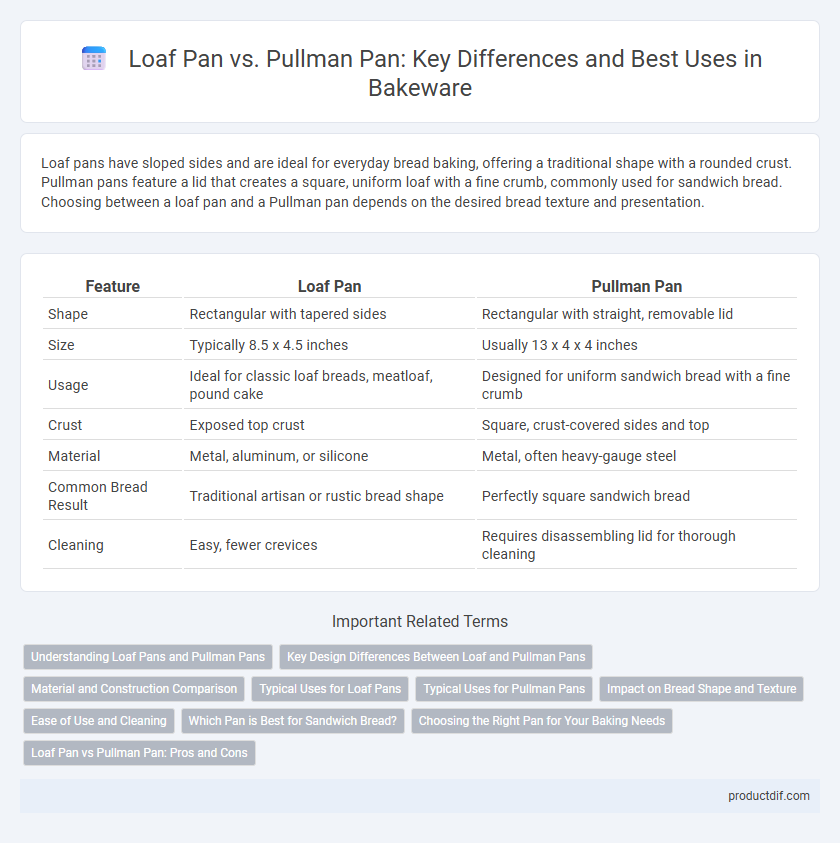Loaf pans have sloped sides and are ideal for everyday bread baking, offering a traditional shape with a rounded crust. Pullman pans feature a lid that creates a square, uniform loaf with a fine crumb, commonly used for sandwich bread. Choosing between a loaf pan and a Pullman pan depends on the desired bread texture and presentation.
Table of Comparison
| Feature | Loaf Pan | Pullman Pan |
|---|---|---|
| Shape | Rectangular with tapered sides | Rectangular with straight, removable lid |
| Size | Typically 8.5 x 4.5 inches | Usually 13 x 4 x 4 inches |
| Usage | Ideal for classic loaf breads, meatloaf, pound cake | Designed for uniform sandwich bread with a fine crumb |
| Crust | Exposed top crust | Square, crust-covered sides and top |
| Material | Metal, aluminum, or silicone | Metal, often heavy-gauge steel |
| Common Bread Result | Traditional artisan or rustic bread shape | Perfectly square sandwich bread |
| Cleaning | Easy, fewer crevices | Requires disassembling lid for thorough cleaning |
Understanding Loaf Pans and Pullman Pans
Loaf pans typically feature straight or slightly tapered sides and are designed for baking traditional bread loaves with a rounded or domed top, enhancing crust formation. Pullman pans, also known as pain de mie pans, have a lid that creates a perfectly square shape by restricting the dough's rise, resulting in a uniform crumb ideal for sandwiches. Understanding the structural differences between these pans is crucial for selecting the right bakeware to achieve desired bread texture and shape.
Key Design Differences Between Loaf and Pullman Pans
Loaf pans feature sloped sides and a rounded interior, allowing bread to rise and expand naturally, creating a domed shape with a soft crust. Pullman pans have straight, vertical sides and come with a tight-fitting lid that produces a perfectly square loaf with a uniform, dense crumb. The key design difference lies in the lid and shape: loaf pans encourage open-top rising, while Pullman pans control the rise for a compact, sandwich-style bread.
Material and Construction Comparison
Loaf pans are typically made from heavy-gauge steel, aluminum, or coated carbon steel, providing excellent heat conductivity for uniform baking, while Pullman pans often feature non-stick coatings and reinforced steel construction to ensure durability and easy release. The Pullman pan includes a lid that creates a perfectly square loaf, influencing the pan's thickness and heat distribution compared to the more open loaf pan design. Material choices directly impact heat retention, durability, and ease of cleaning, with Pullman pans emphasizing structural integrity for consistent shape and texture in sandwich bread preparation.
Typical Uses for Loaf Pans
Loaf pans are typically used for baking traditional bread loaves, meatloaf, and pound cakes, offering deep, straight sides that help achieve even cooking and a classic loaf shape. Their versatility extends to recipes requiring a sturdy, high-sided vessel, making them ideal for quick breads and dense cakes. Unlike Pullman pans, loaf pans do not have lids, allowing for a crustier exterior on baked goods.
Typical Uses for Pullman Pans
Pullman pans are primarily used for baking uniform, square-shaped sandwich bread with a tight crumb and even crust, ideal for deli-style bread and toast. The pan's lid prevents the dough from rising above the edges, ensuring consistent shape and size, which is essential for professional baking and commercial bread production. Home bakers also favor Pullman pans for making refined, neatly shaped loaves perfect for sandwiches and paninis.
Impact on Bread Shape and Texture
Loaf pans create a taller, domed bread with a crusty exterior and soft crumb, ideal for rustic sandwich loaves. Pullman pans produce a uniformly square shape with a flat top, resulting in a denser texture and consistent crumb, perfect for precise sandwich slices. The choice between these pans directly influences bread's form and mouthfeel, catering to varied baking preferences.
Ease of Use and Cleaning
Loaf pans feature a simple rectangular design with sloped sides, making it easier to remove baked goods and clean after use. Pullman pans have straight sides and a sliding lid, which can complicate cleaning due to tight corners and removable parts. For hassle-free baking and minimal cleanup, loaf pans generally offer greater ease of use compared to Pullman pans.
Which Pan is Best for Sandwich Bread?
A Pullman pan is best for sandwich bread due to its lid, which creates a uniform, square shape ideal for evenly sliced, perfectly shaped sandwich loaves. A loaf pan produces a more traditional rounded bread shape, which may not yield uniform slices for sandwiches but offers more crust variation. For consistent size and texture in sandwich bread, the Pullman pan outperforms the loaf pan.
Choosing the Right Pan for Your Baking Needs
A loaf pan is ideal for classic breads and quick breads, offering a traditional shape with sloped sides that promote even baking and easy slicing. Pullman pans, equipped with a lid, create a perfectly square loaf with a fine crumb, making them perfect for sandwiches and uniform slices. Selecting the right pan depends on the desired bread shape, texture, and presentation, with loaf pans suited for rustic loaves and Pullman pans preferred for precise, compact loaves.
Loaf Pan vs Pullman Pan: Pros and Cons
Loaf pans provide a classic shape ideal for traditional bread with a rounded top and are easier to use for recipes requiring taller, domed loaves, while Pullman pans produce uniform, square-shaped loaves perfect for sandwich bread and even slices. Pullman pans often include a lid that prevents crust formation, yielding a soft, compact crumb but can limit crust development, whereas loaf pans allow for a crustier exterior. Choosing between loaf and Pullman pans depends on desired bread texture and presentation, with loaf pans excelling in artisanal aesthetics and Pullman pans suited for consistent, commercial-style sandwiches.
Loaf pan vs Pullman pan Infographic

 productdif.com
productdif.com